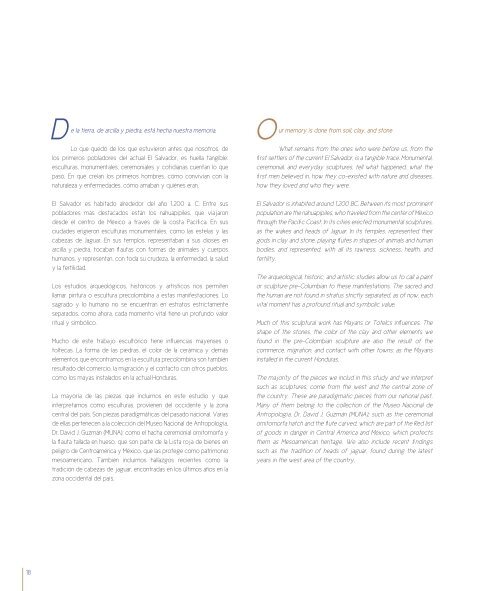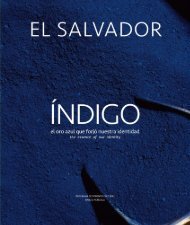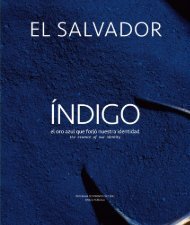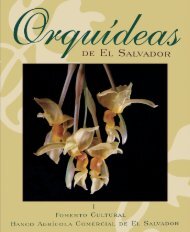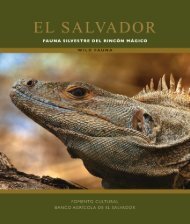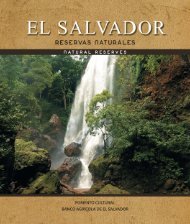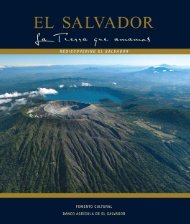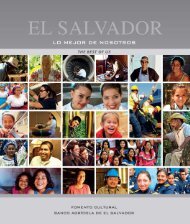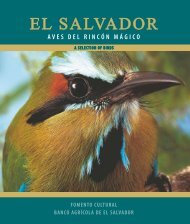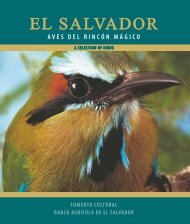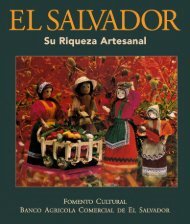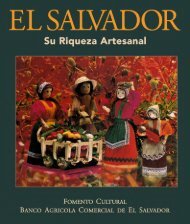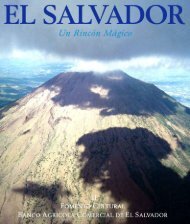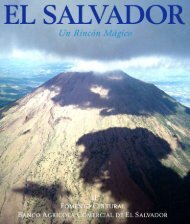Monumentos y Esculturas del Rincón Mágico
You also want an ePaper? Increase the reach of your titles
YUMPU automatically turns print PDFs into web optimized ePapers that Google loves.
De la tierra, de arcilla y piedra, está hecha nuestra memoria.<br />
O<br />
ur memory is done from soil, clay, and stone<br />
Lo que quedó de los que estuvieron antes que nosotros, de<br />
los primeros pobladores <strong>del</strong> actual El Salvador, es huella tangible:<br />
esculturas, monumentales, ceremoniales y cotidianas cuentan lo que<br />
pasó. En qué creían los primeros hombres, cómo convivían con la<br />
naturaleza y enfermedades, cómo amaban y quiénes eran.<br />
El Salvador es habitado alrededor <strong>del</strong> año 1,200 a. C. Entre sus<br />
pobladores más destacados están los nahuapipiles, que viajaron<br />
desde el centro de México a través de la costa Pacífica. En sus<br />
ciudades erigieron esculturas monumentales, como las estelas y las<br />
cabezas de Jaguar. En sus templos, representaban a sus dioses en<br />
arcilla y piedra, tocaban flautas con formas de animales y cuerpos<br />
humanos, y representan, con toda su crudeza, la enfermedad, la salud<br />
y la fertilidad.<br />
Los estudios arqueológicos, históricos y artísticos nos permiten<br />
llamar pintura o escultura precolombina a estas manifestaciones. Lo<br />
sagrado y lo humano no se encuentran en estratos estrictamente<br />
separados, como ahora, cada momento vital tiene un profundo valor<br />
ritual y simbólico.<br />
Mucho de este trabajo escultórico tiene influencias mayenses o<br />
toltecas. La forma de las piedras, el color de la cerámica y demás<br />
elementos que encontramos en la escultura precolombina son también<br />
resultado <strong>del</strong> comercio, la migración y el contacto con otros pueblos,<br />
como los mayas instalados en la actual Honduras.<br />
La mayoría de las piezas que incluimos en este estudio y que<br />
interpretamos como esculturas, provienen <strong>del</strong> occidente y la zona<br />
central <strong>del</strong> país. Son piezas paradigmáticas <strong>del</strong> pasado nacional. Varias<br />
de ellas pertenecen a la colección <strong>del</strong> Museo Nacional de Antropología,<br />
Dr. David J. Guzmán (MUNA); como el hacha ceremonial ornitomorfa y<br />
la flauta tallada en hueso, que son parte de la Lista roja de bienes en<br />
peligro de Centroamérica y México, que las protege como patrimonio<br />
mesoamericano. También incluimos hallazgos recientes como la<br />
tradición de cabezas de jaguar, encontradas en los últimos años en la<br />
zona occidental <strong>del</strong> país,<br />
What remains from the ones who were before us, from the<br />
first settlers of the current El Salvador, is a tangible trace. Monumental,<br />
ceremonial, and everyday sculptures, tell what happened, what the<br />
first men believed in, how they co-existed with nature and diseases,<br />
how they loved and who they were.<br />
El Salvador is inhabited around 1,200 BC. Between its most prominent<br />
population are the nahuapipiles, who traveled from the center of México<br />
through the Pacific Coast. In its cities erected monumental sculptures,<br />
as the wakes and heads of Jaguar. In its temples, represented their<br />
gods in clay and stone, playing flutes in shapes of animals and human<br />
bodies, and represented, with all its rawness, sickness, health, and<br />
fertility.<br />
The arqueological, historic, and artistic studies allow us to call a paint<br />
or sculpture pre-Columbian to these manifestations. The sacred and<br />
the human are not found in stratus strictly separated, as of now, each<br />
vital moment has a profound ritual and symbolic value.<br />
Much of this sculptural work has Mayans or Totelcs influences. The<br />
shape of the stones, the color of the clay and other elements we<br />
found in the pre-Colombian sculpture are also the result of the<br />
commerce, migration, and contact with other towns; as the Mayans<br />
installed in the current Honduras.<br />
The majority of the pieces we includ in this study and we interpret<br />
such as sculptures, come from the west and the central zone of<br />
the country. These are paradigmatic pieces from our national past.<br />
Many of them belong to the collection of the Museo Nacional de<br />
Antropología, Dr. David J. Guzmán (MUNA); such as the ceremonial<br />
ornitomorfa hatch and the flute carved, which are part of the Red list<br />
of goods in danger in Central America and México, which protects<br />
them as Mesoamerican heritage. We also include recent findings<br />
such as the tradition of heads of jaguar, found during the latest<br />
years in the west area of the country.<br />
18


